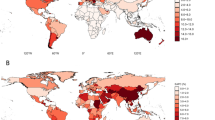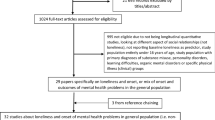Abstract
Objectives
Major depression in South Korea, which remains under-diagnosed and under-treated, increases the risk of premature death, and reduces quality of life and work productivity. The aim of this study was to quantify the depression-related health and productivity loss in South Korea in terms of life-years lost and productivity-adjusted life-years (PALYs) lost.
Method
Age and sex-specific life table models simulated follow-up of South Koreans with depression aged 15 to 54 years, until 55 years. Depression was defined as major depression. Inputs were drawn from national datasets and published sources. Models were constructed for the cohort with depression and repeated assuming they had no depression. Differences in total deaths, years of life, and PALYs represented the impact of depression. PALYs were ascribed a financial value equivalent to total gross domestic product (GDP) divided by the number of equivalent full-time workers (KRW81,507,146 or USD74,748). All outcomes were discounted by 3% per annum.
Results
In 2019, there were more than 500,000 people aged 15–54 years with major depression in South Korea. We predicted that until this cohort reached age 55 years, and assuming 22.2% of people with depression are treated, depression led to 12,000 excess deaths, more than 55,000 discounted years of life lost and 1.6 million discounted PALYs lost, equating to KRW133 trillion (USD122 billion) in lost GDP. Applying treatment-related response and remission rates of 11.8% and 42.1%, respectively, and a non-response/non-remission rate of 46.1%, increased the total number of PALYs lost by almost 6.0%.
Conclusions
Our study highlights the considerable productivity loss attributable to depression among South Koreans over their working lifetime. Better prevention and treatment of depression is needed for long-term economic gains.
Similar content being viewed by others
References
Korea Statistics. The survey of mental disorders in Korea 2016. Daejeon, Korea: Korea Statistics; 2017.
Shin C, Kim Y, Park S, et al. Prevalence and associated factors of depression in general population of Korea: results from the Korea National Health and Nutrition Examination Survey, 2014. J Korean Med Sci. 2017;32(11):1861–9.
Cho MJ, Seong SJ, Park JE, et al. Prevalence and correlates of DSM-IV Mental Disorders in South Korean Adults: the Korean Epidemiologic Catchment Area Study 2011. Psychiatry Investig. 2015;12(2):164–70.
Hawton K, van Heeringen K. Suicide. Lancet. 2009;373(9672):1372–81.
Koo SK. Depression status in Korea. Osong Public Health Res Perspect. 2018;9(4):141–2.
Organisation for Economic Co-operation and Development. OECD Data: Suicide rates. Paris: OECD; 2018. https://data.oecd.org/healthstat/suicide-rates.htm.
Korea Statistics. Statistics Report for Causes of Death 2019. Sejong: Korea Statistics; 2020.
Jang J, Lee SA, Kim W, Choi Y, Park EC. Factors associated with mental health consultation in South Korea. BMC Psychiatry. 2018;18(1):17.
Hawton K, Casanas ICC, Haw C, Saunders K. Risk factors for suicide in individuals with depression: a systematic review. J Affect Disord. 2013;147(1–3):17–28.
Park JI, Jeon M. The stigma of mental illness in Korea. J Korean Neuropsychiatr Assoc. 2016;55(4):299–309.
Lee YM. Loss of productivity due to depression among Korean employees. J Occup Health. 2010;52(6):389–94.
Evans-Lacko S, Knapp M. Global patterns of workplace productivity for people with depression: absenteeism and presenteeism costs across eight diverse countries. Soc Psychiatry Psychiatr Epidemiol. 2016;51(11):1525–37.
Hird TR, Zomer E, Owen A, Chen L, Ademi Z, Magliano DJ, et al. The impact of diabetes on productivity in China. Diabetologia. 2019;62(7):1195–203.
Hird TR, Zomer E, Owen AJ, Magliano DJ, Liew D, Ademi Z. Productivity burden of hypertension in Australia. Hypertension. 2019;73(4):777–84.
Magliano DJ, Martin VJ, Owen AJ, Zomer E, Liew D. The productivity burden of diabetes at a population level. Diabetes Care. 2018;41(5):979–84.
Owen AJ, Maulida SB, Zomer E, Liew D. Productivity burden of smoking in Australia: a life table modelling study. Tob Control. 2019;28(3):297–304.
Tan QY, Zomer E, Owen AJ, Chin KL, Liew D. Impact of tobacco use on health and work productivity in Malaysia. Tob Control. 2019;29(1):111–7.
Ademi Z, Ackerman IN, Zomer E, Liew D. Productivity-adjusted life years: a new metric for quantifying disease burden. Pharmacoeconomics. 2021. https://doi.org/10.1007/s40273-020-00999-z.
Korea Statistics. Korean Statistical Information Service Site. Daejeon: Korea Statistics; 2020.
Institute for Health Metrics and Evaluation. IHME data: GBD Results Tool. Seattle: IHME, University of Washington; 2019.
Cuijpers P, Vogelzangs N, Twisk J, Kleiboer A, Li J, Penninx BW. Is excess mortality higher in depressed men than in depressed women? A meta-analytic comparison. J Affect Disord. 2014;161:47–54.
Briggs A, Claxton K, Sculpher M. Decision modelling for health economic evaluation. Oxford: Oxford University Press; 2016.
Woo JM, Kim W, Hwang TY, Frick KD, Choi BH, Seo YJ, Kang EH, Kim SJ, Hang BJ, Lee JS, Park YL. Impact of depression on work productivity and its improvement after outpatient treatment with antidepressants. Value Health. 2011;14(4):475–82.
Thornicroft G, Chatterji S, Evans-Lacko S, et al. Undertreatment of people with major depressive disorder in 21 countries. Br J Psychiatry. 2017;210(2):119–24.
The World Bank. Data bank: World Development Indicators. Washington DC: The World Bank Group; 2019.
XE Currency Converter. 1 USDto KRW = 1,090.42 South Korean Won. https://www.xe.com/currencyconverter/convert/?From=USD&To=KRW. Accessed 13 Dec 2020.
World Health Organization, Baltussen R, Adam T, Tan-Torres Edejer T, et al. Making choices in health: WHO guide to cost-effectiveness analysis/edited by T. Tan-Torres Edejer ... [et al]. Geneva: World Health Organization; 2003.
Beck A, Crain AL, Solberg LI, Unutzer J, Maciosek MV, Whitebird RR, Rossom RC. The effect of depression treatment on work productivity. Am J Manag Care. 2014;37(3):e294–301.
Tundia N, Hass S, Fuldeore M, Wang LL, Cavanaugh T, Boone J, Heaton P. Validation and U.S. population norms of health-related productivity questionnaire. Value Health. 2015;18(3):PA24.
DiBernardoA, Lin X, Zhang Q, Viang J, Lu L, Jamieson C, Benson C, Lee K, Boden R, Brandt L, Brenner P, Reutfors J, Li G. Humanistic outcomes in treatment resistant depression: a secondary analysis of the STAR*D study. BMC Psychiatry 2018;18(1):352.
International Society of Pharmacoeconomics and Outcomes Research. Pharmacoeconomic guidelines around the world. USA: ISPOR, 2018. https://tools.ispor.org/PEguidelines/countrydet.asp?c=28&t=4. Accessed Aug 2019.
Choi KS, Yang JH, Kye SY, et al. Factors associated with performance of national cancer screening program in Korea. J Prev Med Public Health. 2004;37(3):246–52.
Ministry of Health. Guide for mental health projects and programs in Korea. Seojong: Ministry of Health; 2019.
Choi E, Kim M, Kiim J, Park J. A study on mental health improvement policy for children and adolescents: Current state of mental health enhancement policy and future plan. Research Report 11-R22-2. Seoul: National Youth Policy Institute; 2011.
National Health Insurance Service. South Korea: NIHS. 2019. https://www.nhis.or.kr/static/html/wbd/g/a/wbdga0101.html.
Ghebreyesus TA. The WHO special initiative for mental health (2019–2023): Universal health coverage for mental health. Switzerland: WHO; 2019. https://apps.who.int/iris/bitstream/handle/10665/310981/WHO-MSD-19.1-eng.pdf?sequence=1&isAllowed=y.
National Health Service. NHS mental health implementation plan 2019/2020–2023/24. United Kingdom: NHS; 2019. https://www.longtermplan.nhs.uk/wp-content/uploads/2019/07/nhs-mental-health-implementation-plan-2019-20-2023-24.pdf.
Department of Health and Human Services. Substance abuse and mental health services administration, fiscal year 2021. United States: DHHS: SAMHSA, 2020. https://www.samhsa.gov/sites/default/files/about_us/budget/fy-2021-samhsa-cj.pdf.
Joukamaa M, Heliovaara M, Knekt P, Aromaa A, Raitasalo R, Lehtinen V. Mental disorders and cause-specific mortality. Br J Psychiatry. 2001;179:498–502.
Mykletun A, Bjerkeset O, Dewey M, Prince M, Overland S, Stewart R. Anxiety, depression, and cause-specific mortality: the HUNT study. Psychosom Med. 2007;69:323–31.
Pan A, Lucas M, Sun Q, Van Dam RM, Franco OH, Willett WC, Manson JE, Rexrode KM, Ascherio A, Hu FB. Increased mortality risk in women with depression and diabetesmellitus. Arch Gen Psychiatry. 2011;68:42–50.
Bruce ML, Leaf PJ, Rozal GPM, Florio L, Hoff RA, Phil M. Psychiatric status and 9-year mortality data in the New Haven Epidemiologic Catchment Area Study. Am J Psychiatry. 1994;151:716–21.
Murphy JM, Burke JD Jr, Manson RR, Horton NJ, Laird NM, Lesage A, Sobol AM, Leighton AH. Mortality associated with depression: a forty-year perspective from the Stirling County Study. Soc Psychiatry Psychiatr Epidemiol. 2008;43:594–601.
Nabi H, Shipley MJ, Vahtera J, Hall M, Korkeila J, Marmot MG, Kivimaki M, Singh-Manoux A. Effects of depressive symptoms and coronary heart disease and their interactive associations on mortality in middle-aged adults: the Whitehall II cohort study. Heart. 2010;96:1645–50.
Patten SB, Williams JVA, Lavorato D, Wang JL, Khaled S, Bulloch AGM. Mortality associated with major depression in a Canadian community cohort. Can J Psychiatry. 2011;56:658–66.
Sohn JH, Ahn SH, Seong SJ, Ryu JM, Cho MJ. Prevalence, work-loss days and quality of life of community dwelling subjects with depressive symptoms. J Korean Med Sci. 2013;28(2):280–6.
Author information
Authors and Affiliations
Corresponding author
Ethics declarations
Funding
This research received no specific grant from any funding agency, commercial or not-for-profit sectors.
Conflict of interest
EZ reports grants from Amgen, AstraZeneca, Pfizer and Shire; outside the submitted work. DL reports grants from Abbvie, Amgen, AstraZeneca, Bristol-Myers Squibb, Pfizer and Sanofi; and past participation in advisory boards and/or receipt of honoraria from Abbvie, Amgen, Astellas, AstraZeneca, Bristol-Myers Squibb, Edwards Lifesciences, Novartis, Pfizer, Sanofi and Shire. All other authors have no conflicts of interest to disclose.
Ethics approval
This research employed published and publicly available data only, and therefore ethics approval was not needed.
Consent to participate
Individual participants were not included in this study as only published and publicly available data were employed, and therefore consent was not needed.
Consent for publication
Individual participants were not included in this study, and therefore consent for publication was not needed.
Availability of data and material
All data generated or analysed during this study are included in this published article [and its supplementary information files].
Code availability
The codes generated during the current study are available from the corresponding author on reasonable request.
Author contributions
EZ, YR, DL, and ZA contributed to the conception or design of the work. EZ and YR contributed to the acquisition, analysis, or interpretation of data for the work. EZ and YR drafted the manuscript. All critically revised the manuscript. All gave final approval of the version to be published and agree to be accountable for all aspects of work ensuring integrity and accuracy.
Supplementary Information
Below is the link to the electronic supplementary material.
Rights and permissions
About this article
Cite this article
Zomer, E., Rhee, Y., Liew, D. et al. The Health and Productivity Burden of Depression in South Korea. Appl Health Econ Health Policy 19, 941–951 (2021). https://doi.org/10.1007/s40258-021-00649-1
Accepted:
Published:
Issue Date:
DOI: https://doi.org/10.1007/s40258-021-00649-1




